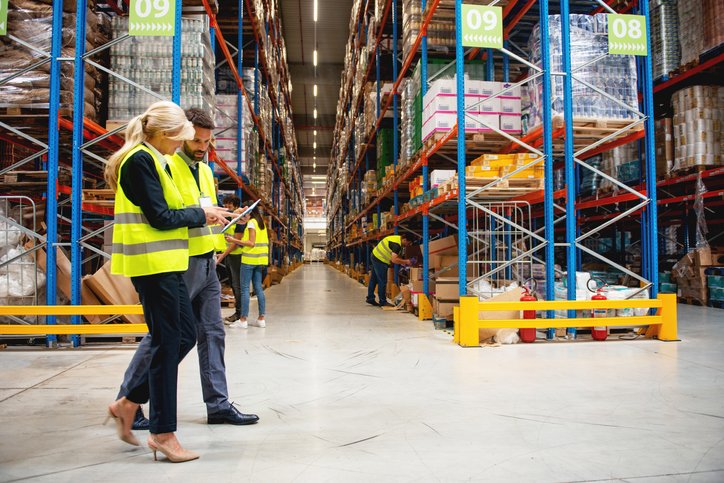Industrial maintenance is a collection of timed, targeted actions aimed at maximizing value from organizational investments in assets and equipment by increasing productive uptime through improved reliability. But what does that mean in plain English? And what does industrial maintenance mean for you?
Definition of industrial maintenance
Industrial maintenance is the work the maintenance department does to keep assets and equipment up and running so the overall organization gets its money’s worth. It’s how you ensure the right returns on your investments in assets and equipment.
Basics and benefits of industrial maintenance
When you carefully plan, schedule, and track a maintenance program, you can save a lot, in a lot of different ways.
You save the overall organization money by helping it avoid costly unscheduled asset and equipment failures. When an asset goes down, costs quickly pile up.
For example, imagine just one asset or piece of equipment in a long production line stops working. First, there are the costs of the parts, people, and materials you need to make the repairs. But because the whole line sits idle while the maintenance team works, the organization is paying all those operators to not work but instead wait.
And those are just the immediate costs. Later, to catch up with the production schedule, the organization might have to run extra shifts, paying overtime rates. On top of that, poor maintenance leading to frequent breakdowns shortens an asset’s useful life, forcing the organization into a costly replacement process sooner than it should have.
With the right industrial maintenance plans in place, you can save yourself from always being over budget and never seeing a return on investment for your assets and equipment.
You can also leverage industrial maintenance to save yourself from a lot of frustration by making your day-to-day maintenance work more predictable.
When you can schedule everything in advance so that maintenance isn’t about just running around putting out fires, life becomes a lot less hectic because you now know ahead of time what’s going to get done and who’s going to do it. Also, you know what they’re going to need for parts and materials, so you can more easily control your inventory. Everyone has what they need when they need it but without the extra costs of rush deliveries.
Common maintenance strategies
Because there are so many different types of assets and equipment, there’s no one perfect maintenance strategy. Looking after the motor in an industrial freezer is different than making sure the ramps in the parking garage are free of cracks. You avoid different problems using different techniques.
And it’s not only because there are different types of assets. Depending on your general industry or specific operation, there are differences in asset criticality, a measure of relative importance. For example, a forklift might have a high criticality in a warehouse, where drivers use it every day, but a low criticality in a municipal water treatment plant, where it’s only ever used a few times a week.
Here are some of the more common strategies for industrial maintenance.
Run-to-failure, reactive
Although it tends to have a bit of a well-earned bad reputation, run-to-failure, reactive maintenance is often your best choice.
The good: When you use it for the right types of assets, you save money because you’re able to get all the value out of your investment.
But you have to make sure you’re using it with the right assets and equipment
You need to be able to check most of the following boxes:
- Cheap to buy
- Easy to carry in inventory
- Hard to inspect
- Expensive to repair
The best example of this is a light bulb.
The bad and the ugly: For all other assets and equipment, run-to-failure ends up costing you a lot of money and heartache. Because you’re waiting until things break before you fix them, the maintenance team spends all its time running around putting out fires.
And many of those fires are big and expensive.
Predictive maintenance
With preventive maintenance, you set up a schedule of future inspections and tasks. With predictive maintenance, you use specialized sensors to collect a continuous stream of data you feed into a sophisticated computer program that tells you when to perform maintenance.
There are many benefits to being able to accurately predict the future, but you have to weigh those against the connected costs. Sensitive sensors, specialized training, and complex software all require upfront investments of time and money. Predictive maintenance makes good sense for expensive, critical assets and equipment.
But it’s important to remember that currently, it only makes sense for those types of assets and equipment. As the technology matures and prices come down, it will start to make economic sense in more places.
Industries that benefit from industrial maintenance
Industrial maintenance is popular in many different industries, especially those that are asset heavy.
Manufacturing
When your entire reason for being in business is taking raw feed material and pushing it through assets and equipment to produce products, even small, unexpected failures have direct impacts on your budget and the bottom line. Maintenance teams in manufacturing ensure the line stays up and running.
Health care
Many of the people at health care centers are physically fragile, so it’s critical for maintenance teams to keep both the physical infrastructure and the medical equipment running properly. Safety is important everywhere, but it’s especially important in health care facilities where many people are already sick or injured.
What might be a small accident or minor delay somewhere else can easily lead to serious consequences in a hospital. So, everything from the elevators that transport patients on gurneys to the bedside oxygen concentrators needs constant care. When seconds count, medical staff need to know they can rely on the lifesaving equipment throughout the facility.
Hospitality
When your industry promises to deliver everything from the comforts of a home away from home and a total escape from daily life, everything needs to look and work perfectly.
No one wants to swim in a pool with a broken heater and then return to their room only to discover the AC isn’t working. Maintenance teams work with a variety of asset and equipment types, from hallway ice machines to industrial freezers, from fire suppression systems to kitchen deep fryers.
Municipalities
At hotels, everything is focused on guests having a good time. For local governments, the challenges are a bit wider: everything from meeting the basic needs of life and work to recreation. Local governments are responsible for running water treatment plants, traffic lights, community swimming pools, and public skating rinks. And not only are the assets spread out over a large area, but operating budgets are often stretched, too.
Industrial maintenance qualifications and certificates
There are many professional organizations and certifications for industrial maintenance professionals.
Certified Maintenance & Reliability Technician (CMRT)
Managed by the Society for Maintenance and Reliability Professionals (SMRP), it’s a comprehensive certification covering general maintenance management, covering maintenance practices, preventative and predictive maintenance, troubleshooting and analysis, and corrective maintenance.
Certified Maintenance & Reliability Professional (CMRP)
Also from the SMRP, this covers business and management, equipment reliability, manufacturing process reliability, organization and leadership, and work management. Accredited by the American National Standards Institute (ANSI).
Certified Facility Manager (CFM)
International Facility Management Association (IFMA) trains workers in the technical specifics of facility maintenance and also leadership and operational concepts. The organization offers a wide variety of educational opportunities.
Facilities Management Professional (FMP)
IFMA offers this degree program for facility management professionals who want to improve both hard and soft skills. The four modules cover finance and business, operations and maintenance, leadership and strategy, and project management. The organization promotes it as the “must-have credential for facility professionals.”
Essentials of Facility Management
Another program from IFMA, this one is better suited for professionals closer to the start of their careers in the industry. The ten modules cover the basics of FM, helping build a strong foundation in key concepts.
Certified Plant Engineer (CPE)
Association for Facilities Engineering (AFE) provides training and certification for facility maintenance, electrical, civil, and mechanical engineering, OSHA safety, and energy management.
ProFM Credential
The ProFMI Commission, which includes Stormy Friday and Stan Mitchell, offers this credential that covers the “24 things every FM professional should know,” including operations and maintenance and how to manage assets, risk, and business.
Canadian Manufacturers and Exporters also offer a wide range of certificate programs and workshops.
Recent developments in industrial maintenance
Just like every other organized effort, maintenance used to run on a combination of grit and paperwork. Maintenance professionals planned and tracked projects on paper, manually copying and sharing data.
The results were impressive. Remember, The Seven Wonders of the Ancient World, including the Great Pyramid of Giza and the Colossus of Rhodes, were all built and maintained using traditional manual maintenance tracking methods. But for all those successes, there are many more frustrating failures. In the end, trying to track maintenance on paper is slow and unreliable. It’s too easy to lose data, and even if you can keep it safe, it’s hard to share.
When computers became more widespread and many departments switched to spreadsheets, they solved some of the common problems only by introducing new ones. Now, instead of lacking data, maintenance departments were producing too much of it, without reliable processes for keeping it all up to date.
Data, thanks to advancing technologies, powers modern industrial maintenance. Maintenance professionals use new technologies to capture, safeguard, share, and leverage data into actionable insights into their operations.
Drones
The light at the top of the Empire State Building has just gone out. But instead of sending a tech out to check, you can now fly a drone for a faster, safer visual inspection. It’s faster because you don’t have to prepare any special safety equipment or call in your most experienced and bravest tech. It’s also much safer, with the operator controlling everything from the ground.
Sensors
Drones work well with scheduled inspections, but for some assets, it makes more sense to have a continuous stream of data. Here, you can attach sensors to your assets to check for:
- Temperature
- Vibration
- Humidity
- Pressure
- Gas
- Security
In some cases, the sensor warns you once it goes above or below preset perimeters. For example, a freezer goes above a set temperature or a pipe below a set pressure. Now you know about potential failures early enough to avoid costly downtime.
But in others, the sensor sends a stream of data to sophisticated software that uses it to make predictions about when the asset will most likely fail.
Digital twins
The challenge with predictive models is collecting the right data. How do you know the signs of an impending failure? You need the asset to fail before you know what it looks like right before it fails. And you would need it to fail in every possible way so you could know what it looks like before each type of failure.
With something small and cheap, it might be worth breaking it over and over to get this data. But with something big and expensive, it’s just not possible.
Unless, that is, you have a near-perfect digital copy of the asset you can endlessly manipulate, break, and rebuild. Digital twins, versions of the assets that live inside computer memory, help maintenance professionals capture the data they need to build out the predictive models they can then apply to the physical original.
You can set up, schedule, and track a PM program all from the same cloud-based platform, confident that your data is safe, secure, and accessible from one database. Modern preventive maintenance solutions also help centralize and streamline work order management and MRO inventory controls.
Summary
Industrial maintenance is how organizations ensure they maximize returns on their investments in assets and equipment by avoiding costly downtime and repairs. Because there are so many different types of assets, and each one can have a different level of importance, there are different maintenance strategies, including reactive to proactive and even predictive.
Although everything used to be done on paper, maintenance departments can now leverage cloud-based computing to keep data safe, secure, and accessible.
Recent developments include the use of drones and sophisticated digital twins, but because of the associated costs for implementation and upkeep, many maintenance departments can meet all their needs with modern preventive maintenance software.




